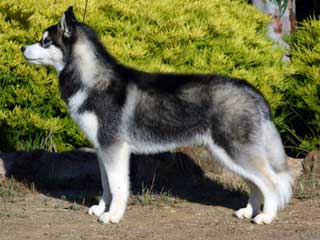| Grooming: |  |  |  |  |  |  |
| Shedding: |  |  |  |  |  |  |
| Energy Level: |  |  |  |  |  |  |
| Protection: |  |  |  |  |  |  |
| Watch Dog: |  |  |  |  |  |  |
| Group: | Working |
| Size: | Medium |
| Life Span: | 12-15 years |
| Height: | Male: 21-24 inches |
| Female: 20-22 inches | |
| Weight: | Male: 45-60 lbs |
| Female: 35-50 lbs |
Siberian Husky Facts
| Coat : | Outercoat is thick, smooth and straight. Undercoat is soft and dense |
| Gait : | Free and effortless |
| Color(s) : | Any |
| Living Area : | Average |
| Hair Length: | Medium |
| Exercise Need : | Daily long walk and jog |
| Recognized By : |
(CKC) Canadian Kennel Club (FCI) F�d�ration Cynologique Internationale (AKC) American Kennel Club (UKC) United Kennel Club (KCGB) Kennel Club of Great Britain (CKC) Canadian Kennel Club (ANKC) Australian National Kennel Council (NKC) National Kennel Club (NZKC) New Zealand Kennel Club (APRI) America Pet Registry, Inc. (ACR) American Canine Registry (DRA) Dog Registry of America |
| Date of Origin : | Ancient |
| Place of Origin : | Siberia |
| Todays Use : | Companion Dog, Sled Dog |
| Originally Used : | Sled Dog |
| Other Name : | Husky, Chukcha |
Siberian Husky Information
Siberian Husky Description:The origin of the Siberian Husky lies in Siberia. It is regarded as one of the oldest breeds of dogs along with other dog breeds such as the Malamutes and the Samoyed. The breed descended from the oldest known Eskimo dogs which were used for Eskimos as sled dogs. In fact, pulling heavy loads over long distances in tough weather conditions was the primary use of this breed. It was in early part of the 20th century that the breed was taken to Alaska during the Gold Rush. While there, it was also used in dog races as well as became very popular during the outbreak of diphtheria epidemic in Nome. During the epidemic, Siberian Husky was used for carrying medicines to different parts of the region. The breed has also served in the Arctic Search and Rescue Unit in the Second World War. It was first recognized by the AKC in 1930. |
Siberian Husky Care & Grooming:The Siberian Husky is an average shedder and sheds heavily during spring and fall. Brushing 3-4 times a week and almost daily brushing during shedding season is required to maintain a healthy looking coat. It should be bathed only when necessary and must be dried properly after each bath. Its eyes and ears need to be cleaned properly to avoid any infection. The hair around its eyes, ears and paws, and nails should be trimmed regularly. |
Siberian Husky Health Problems:The Siberian Husky is prone to some health issues like Cataract, PRA, Gastric disease etc. |
| Group: | Hound |
| Size: | Medium |
| Life Span: | 10-12 years |
| Height: | Male: 20-22 inches Female: 18-20 inches |
| Weight: | Male:50-60 lbs Female: 40-50 lbs |
| Color: | Any |
| Description: | The origin of the Harrier dates back to the 13th century when Sir Elias Medophe developed the fi..... |












-119.jpg)